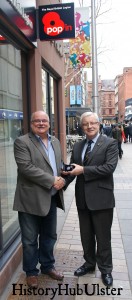As 2018 is the centenary of the Armistice on the Western Front, signed on 11th November 1918, History Hub Ulster felt it would be appropriate to produce a book, Ulster War Memorials to commemorate this important centenary.
Whilst HHU Researcher Nigel Henderson had already photographed many memorials in Ulster, the main driving force behind the book, Ulster War Memorials is HHU Chair Gavin Bamford, who has had a long-standing interest in war memorials.
 In the Preface to the book, Gavin says,
In the Preface to the book, Gavin says,
“I first began to take an interest in war memorials whilst researching the employees of the Belfast Banking Company and the Northern Banking Company who gave their lives in the Great War. In addition to brass tablets listing those who served and the fatalities, both banks produced a series of studio portraits of the men. Currently, the brass tablets and portraits are located in the Head Office building of Northern Bank t/a Danske Bank. They are displayed in the basement and only accessible to the general public on request.”
Gavin recalls that a specific interest in war memorials that have been hidden, lost, or destroyed over time occurred whilst enjoying a cup of coffee in Flame restaurant on Howard Street in Belfast.
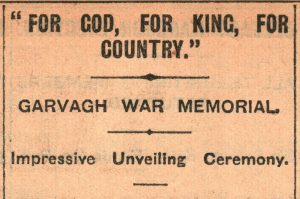
“I noticed a plaque and, being curious, I went over to have a look. It transpired to be a commemoration of the laying of the foundation stone for the Presbyterian War Memorial Hostel in 1923. The stone had been covered over at some stage in the past, probably when the Skandia restaurant occupied the space, and had been uncovered during renovations by the current owners. They decided to retain the stone as part of the fabric and history of the building. More recently, I identified that the war memorial tablet from Elmwood Presbyterian Church in Belfast, which closed in the early 1970s, was held in a store room in Elmwood Presbyterian Church in Lisburn. Whilst, I knew about the war memorial tablets in Central Station in Belfast and Connolly Station in Dublin, I only recently discovered that a tablet had also been erected in the Londonderry terminus. It is in storage and I have initiated steps to get it renovated and re-erected. It is my hope that the memorials for the men from the three local railway companies will be brought together in one location in Weaver’s Cross, the new Belfast Transport Hub.”
Nigel Henderson had the task of compiling material relating to war memorials in Ulster, covering all nine counties of Ulster and identifying unique and interesting examples to feature in a forty-page book. No easy task, given the wide range of types of memorials and the research presented distractions – for example, German Trophy Guns and War Memorial Orange Halls.
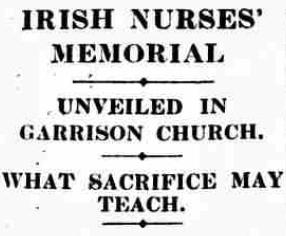
Though the initial concept was for a coffee table book the final product goes a lot further, whilst remaining true to the original idea of focusing on public memorials which have an aspect that is unusual or unique. There is at least one war memorial from each of the nine counties of Ulster in the book – some of the memorials are monuments (cenotaphs, obelisks, statues, etc), some had a practical or community aspect, some were introduced as competition trophies by sporting associations.
It identifies the largest war memorial constructed in Ulster in the inter-war years as well as the tallest memorial and the only war memorial that is alive. For the memorials featured, research was conducted using newspapers and other online resources to identify material about the memorials – details on who designed, sculpted or constructed the memorial, details on when memorials were dedicated and by whom.
Public or town war memorials take many different forms:
• Cenotaph (for example, Belfast, Cookstown, Larne, Newry and the County Tyrone Memorial in Omagh)
• Obelisk (for example, Ballynahinch, Kilrea, Ballymena, Tandragee, Kingscourt)
• Temple (Lurgan)
• “Victory” figure (for example, Lisburn, Portrush, Londonderry)
• Soldiers (for example, County Fermanagh Memorial in Enniskillen, Downpatrick, Dromore and Holywood)
• Celtic Cross (for example, Cregagh, Hillsborough)
• Practical/Functional (for example, Ballinderry, Castledawson)
• Clock Tower (for example, Garvagh, Waringstown)
• Tablet/Plaque (for example, Castlewellan, Moneymore, Pettigo)
• Lychgate (Crumlin)
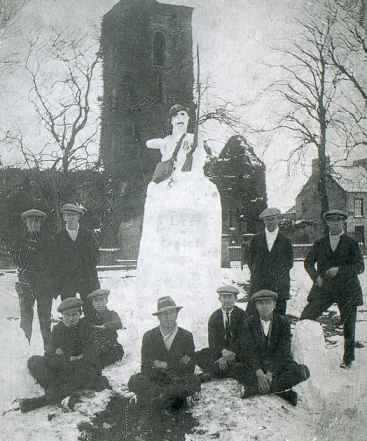
Snowman Memorial, Newtownards, March 1924
In the book’s forward, local historian and author, Philip Orr says,
“As a result, both during and after the Great War, a remarkable and diverse array of memorials was created in Ireland, as indeed happened across these islands. These local memorials often located grief and commemoration in tangible, meaningful ways within particular civic, sacred or familial spaces. Nigel Henderson’s work plays an important role in drawing our attention to the subject, a century later. Despite problems caused by Northern Ireland’s political fractures and by the lack of funds in an inter-war era of poverty and economic downturn, the work went ahead – and Nigel’s thorough and revealing account gives the reader an insight into the motivations and practice of those involved in Ulster’s own memorialisation process. Most of these projects still survive to this day, though some are long gone.”
Whilst the book does cover some church memorials and contains a chapter (Playing The Game) on memorials produced by sporting organisations, the focus is on public memorials erected to commemorate those from a defined locality. There is a chapter that relates to women who died as a result of the war, with a focus on the Irish Nurses Memorial in St Anne’s Cathedral in Belfast. There is also a chapter on memorials with which the Holywood-born sculptor Sophia Rosamund Praeger was associated – these include the memorials in Campbell College and Belfast Royal Academy, several churches within the Non-Subscribing (or Unitarian) Presbyterian denomination, the Workman Clark shipyard and the County Tyrone War Memorial in Omagh.

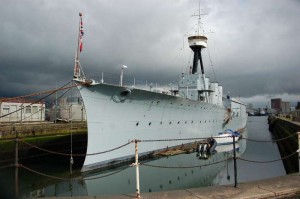 A sea of lights to remember those from North Belfast who died in the First World War.
A sea of lights to remember those from North Belfast who died in the First World War.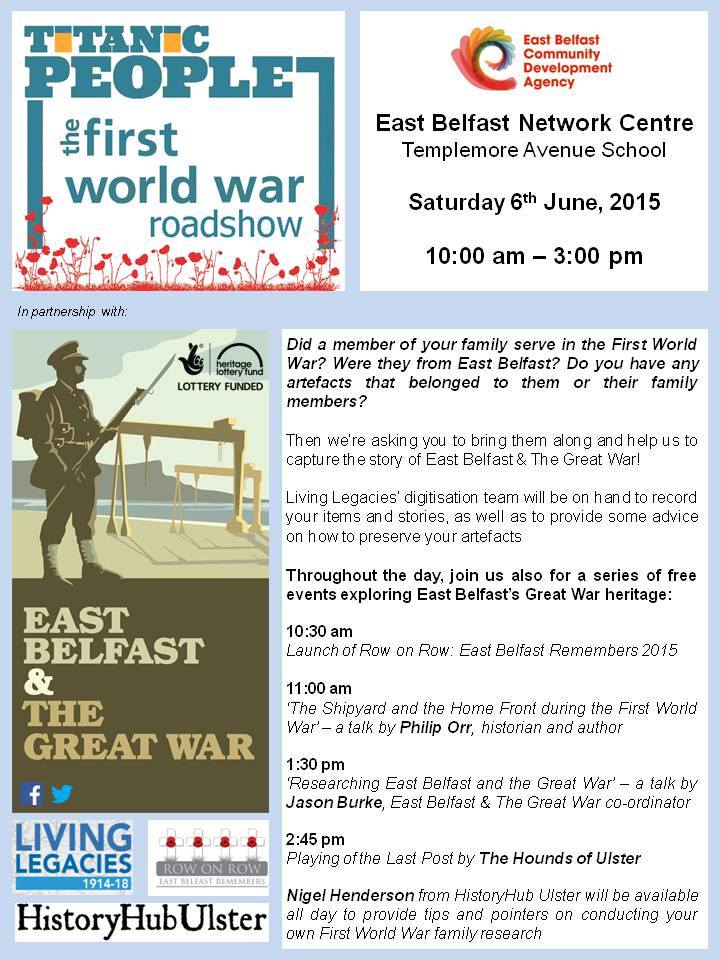
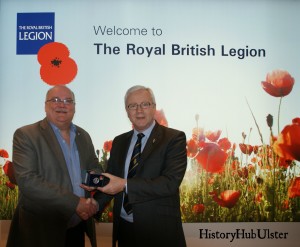
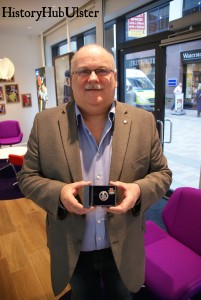 Brian said, “I was browsing in the hope of finding my own grand-fathers lost medals but seeing this badge’s local connection, I believed that it could and should be reunited with Albert Baxter’s family. It was an act of Remembrance really and I posted an appeal on the Facebook page that I administer for the Limerick Branch of the Royal British Legion. Our Belfast following is quite strong and I was confident someone there would be able to help”.
Brian said, “I was browsing in the hope of finding my own grand-fathers lost medals but seeing this badge’s local connection, I believed that it could and should be reunited with Albert Baxter’s family. It was an act of Remembrance really and I posted an appeal on the Facebook page that I administer for the Limerick Branch of the Royal British Legion. Our Belfast following is quite strong and I was confident someone there would be able to help”.